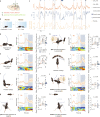Superior Colliculus to VTA pathway controls orienting response and influences social interaction in mice
- PMID: 35145124
- PMCID: PMC8831635
- DOI: 10.1038/s41467-022-28512-4
Superior Colliculus to VTA pathway controls orienting response and influences social interaction in mice
Abstract
Social behaviours characterize cooperative, mutualistic, aggressive or parental interactions that occur among conspecifics. Although the Ventral Tegmental Area (VTA) has been identified as a key substrate for social behaviours, the input and output pathways dedicated to specific aspects of conspecific interaction remain understudied. Here, in male mice, we investigated the activity and function of two distinct VTA inputs from superior colliculus (SC-VTA) and medial prefrontal cortex (mPFC-VTA). We observed that SC-VTA neurons display social interaction anticipatory calcium activity, which correlates with orienting responses towards an unfamiliar conspecific. In contrast, mPFC-VTA neuron population activity increases after initiation of the social contact. While protracted phasic stimulation of SC-VTA pathway promotes head/body movements and decreases social interaction, inhibition of this pathway increases social interaction. Here, we found that SC afferents mainly target a subpopulation of dorsolateral striatum (DLS)-projecting VTA dopamine (DA) neurons (VTADA-DLS). While, VTADA-DLS pathway stimulation decreases social interaction, VTADA-Nucleus Accumbens stimulation promotes it. Altogether, these data support a model by which at least two largely anatomically distinct VTA sub-circuits oppositely control distinct aspects of social behaviour.
© 2022. The Author(s).
Conflict of interest statement
The authors declare no competing interests.
Figures







Similar articles
-
Role of dopamine projections from ventral tegmental area to nucleus accumbens and medial prefrontal cortex in reinforcement behaviors assessed using optogenetic manipulation.Metab Brain Dis. 2017 Oct;32(5):1491-1502. doi: 10.1007/s11011-017-0023-3. Epub 2017 May 19. Metab Brain Dis. 2017. PMID: 28523568
-
Temporally Specific Roles of Ventral Tegmental Area Projections to the Nucleus Accumbens and Prefrontal Cortex in Attention and Impulse Control.J Neurosci. 2021 May 12;41(19):4293-4304. doi: 10.1523/JNEUROSCI.0477-20.2020. Epub 2021 Apr 9. J Neurosci. 2021. PMID: 33837050 Free PMC article.
-
Distinct Neuromodulatory Effects of Endogenous Orexin and Dynorphin Corelease on Projection-Defined Ventral Tegmental Dopamine Neurons.J Neurosci. 2024 Sep 25;44(39):e0682242024. doi: 10.1523/JNEUROSCI.0682-24.2024. J Neurosci. 2024. PMID: 39187377 Free PMC article.
-
Functional relationship among medial prefrontal cortex, nucleus accumbens, and ventral tegmental area in locomotion and reward.Crit Rev Neurobiol. 2000;14(2):131-42. Crit Rev Neurobiol. 2000. PMID: 11513242 Review.
-
Dopamine-glutamate neuron projections to the nucleus accumbens medial shell and behavioral switching.Neurochem Int. 2019 Oct;129:104482. doi: 10.1016/j.neuint.2019.104482. Epub 2019 Jun 3. Neurochem Int. 2019. PMID: 31170424 Free PMC article. Review.
Cited by
-
How social information impacts action in rodents and humans: the role of the prefrontal cortex and its connections.Neurosci Biobehav Rev. 2023 Apr;147:105075. doi: 10.1016/j.neubiorev.2023.105075. Epub 2023 Feb 1. Neurosci Biobehav Rev. 2023. PMID: 36736847 Free PMC article. Review.
-
Pre-existing visual responses in a projection-defined dopamine population explain individual learning trajectories.Curr Biol. 2024 Nov 18;34(22):5349-5358.e6. doi: 10.1016/j.cub.2024.09.045. Epub 2024 Oct 16. Curr Biol. 2024. PMID: 39413788 Free PMC article.
-
Optical dopamine monitoring with dLight1 reveals mesolimbic phenotypes in a mouse model of neurofibromatosis type 1.Elife. 2019 Sep 23;8:e48983. doi: 10.7554/eLife.48983. Elife. 2019. PMID: 31545171 Free PMC article.
-
Superior Colliculus Controls the Activity of the Rostromedial Tegmental Nuclei in an Asymmetrical Manner.J Neurosci. 2021 May 5;41(18):4006-4022. doi: 10.1523/JNEUROSCI.1556-20.2021. Epub 2021 Mar 19. J Neurosci. 2021. PMID: 33741724 Free PMC article.
-
Valproic acid affects neurogenesis during early optic tectum development in zebrafish.Biol Open. 2023 Jan 15;12(1):bio059567. doi: 10.1242/bio.059567. Epub 2023 Jan 31. Biol Open. 2023. PMID: 36537579 Free PMC article.
References
Publication types
MeSH terms
LinkOut - more resources
Full Text Sources

